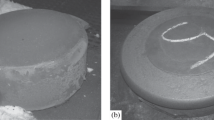Abstract
New low-density single-crystal (IDS) alloys have been developed for turbine blade applications, which have the potential for significant improvements in the thrust-to-weight ratio over current production superalloys. An innovative alloying strategy was used to achieve alloy density reductions, high-temperature creep resistance, micro-structural stability, and cyclic oxidation resistance. The alloy design relies on molybdenum as a potent, lower-density solid-solution strengthener in the nickel-based superalloy. Low alloy density was also achieved with modest rhenium levels and the absence of tungsten. Microstructural, physical, mechanical, and environmental testing demonstrated the feasibility of this new IDS superalloy design.
Similar content being viewed by others
References
M. Gell, D.N. Duhl, and A.F. Giamei, Superalloys 1980, ed. J.K. Tien et al. (Metals Park, OH: American Society for Metals, 1980), pp. 205–214.
R.A. MacKay et al., “Alloy Design Challenge: Development of Low Density Superalloys for Turbine Blade Applications,” NASA TM-2009-215819 (Washington, DC: NASA, 2009), http://gltrs.grc.nasa.gov/Citations.aspx?ID=4661.
Enabling Propulsion Materials Program: Final Technical Report, Volume 4, Task J — Long-Life Turbine Airfoil Materials System, 01 October 1998 to 31 October 1999, NASA Contract NAS 3-26385 (May 2000).
R.A. MacKay et al., “Assessment of Creep Capability of HSR-EPM Turbine Airfoil Alloys,” NASA TM-2007-214921 (Washington, D.C.: NASA, 2007).
S. Walston et al., Superalloys 2004, ed. K.A. Green et al. (Warrendale, PA: TMS, 2004), pp. 15–24. Also NASA/TM-2004-213062.
W.S. Walston et al., Superalloys 1996, ed. R.D. Kissinger et al. (Warrendale, PA: TMS, 1996), pp. 27–34.
G.L Erickson, in Ref. 6, pp. 35–44.
W.S. Walston, J.C. Schaeffer, and W.H. Murphy, in Ref. 6, pp. 9–18.
R.C. Reed, The Superalloys: Fundamentals and Applications (Cambridge, U.K.: Cambridge University Press, 2006), pp. 148–170.
D.N. Duhl, Alloy Phase Stability and Design, vol. 186, ed. G.M. Stocks, D.P. Pope, and A.F. Giamei (Pittsburgh, PA: MRS, 1991), pp. 389–400.
W.S. Walston, Long Term Stability of High Temperature Materials, ed. G.E. Fuchs, K.A. Dannemann, and T.C. Deragon (Warrendale, PA: TMS, 1999), pp. 43–53.
H.R. Gray, NASA Glenn Research Center, private communication with first author (September 2001).
R.A. MacKay and L.J. Ebert, Superalloys 1984, ed. M. Gell et al. (Warrendale, PA: TMS, 1984), pp. 135–144.
R.A. MacKay, M.V. Nathal, and D.D. Pearson, Metall. Trans. A, 21A (1990), pp. 381–388.
A. Cox et al., DARPA Contract F33615-76-C-5136 (1979).
P.L. Martin, H.A. Lipsitt, and J.C. Williams, Proc. Second Int’l. Conf. on Rapid Solidification Processing, ed. R. Mehrabian, B.H. Kear and M. Cohen (Baton Rouge, LA: Claitor’s Publishing Division, 1980), pp. 123–128.
J.L Smialek, C.A. Barrett, and J.C Schaeffer, ASM Handbook: Materials Selection and Design, vol. 20 (Materials Park, OH: ASM International, 1997), pp. 589–602.
J.L. Smialek and R. Browning, Electrochemical Society Symposium Proceedings on High Temperature Materials Chemistry III (Pennington, NJ: Electrochemical Society, 1986), pp. 259–271.
J.G. Smeggil, A.W. Funkenbusch, and N.S. Bornstein, Metall. Trans. A, 17A (1986), pp. 923–932.
R.A. MacKay et al., U.S. patent 7,261,783 B1 (28 August 2007).
Mettler Density Determination Kit ME-40290, Mettler Instrument Corporation, Hightstown, NJ, 1981, pp. 1–5.
Enabling Propulsion Materials Program: Annual Technical Progress Report, Volume 3, Task C — Other Critical Components, 1 January 1993–31 December 1993, NASA Contract NAS3-26385, January 1994.
ASTM Designation: E139-06, “Standard Test Methods for Conducting Creep, Creep-Rupture, and Stress-Rupture Tests of Metallic Materials,” in Volume 3.01 Metals — Mechanical Testing: Elevated and Low-Temperature Tests: Metallography, 2006 Annual Book of ASTM Standards (West Conshohocken, PA: ASTM International, 2006), pp. 319–331.
G.L. Erickson, U.S. patent 5,366,695 (22 November 1994).
J.L. Smialek and B.A. Pint, “Optimizing Scale Adhesion on Single Crystal Superalloys,” NASA/TM-2000-210362 (Washington, DC: NASA, 2000).
Author information
Authors and Affiliations
Corresponding author
Rights and permissions
About this article
Cite this article
MacKay, R.A., Gabb, T.P., Smialek, J.L. et al. A new approach of designing superalloys for low density. JOM 62, 48–54 (2010). https://doi.org/10.1007/s11837-010-0011-0
Published:
Issue Date:
DOI: https://doi.org/10.1007/s11837-010-0011-0




